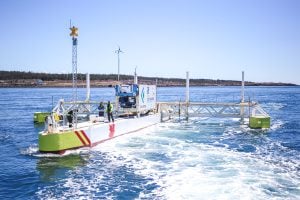
Science & Tech
Energy use in Canada
Where and how we live affect how much energy we consume. Here’s what Canada would look like if the provinces and territories were scaled to represent the amount of energy they use.
- 661 words
- 3 minutes
This article is over 5 years old and may contain outdated information.
Science & Tech

If grizzlies and caribou find the cavernous diamond mines dug into the subarctic tundra 300 kilometres northeast of Yellowknife off-putting, wait until they see the latest change to their landscape: four towering wind turbines reaching 99 metres into the sky.
The 2.3-megawatt turbines, installed by mining giant Rio Tinto at its Diavik Diamond Mine at a cost of around $30 million, are scheduled to be operational in early fall and are expected to provide 17 million kilowatt hours of renewable energy (the equivalent annual electricity use of more than 1,400 homes), or 10 percent of the mine’s energy requirements.
“It’s hugely important because it’s the first industrial use of wind power in a mining operation that we know of in the world,” says Wade Carpenter, a territorial government alternative-energy specialist exploring ways to reduce diesel dependency in 24 remote communities.
Until 2006, the Northwest Territories’ three diamond mines had relied entirely on diesel fuel trucked up a winter ice road, a pollution- spewing trek fraught with increasing uncertainty. That winter, when warm temperatures melted the road, the mines had to fly in fuel, exacerbating greenhouse-gas emissions, which have increased 60 percent in the Northwest Territories since the onset of diamond mining 20 years ago.
Diavik’s wind-diesel hybrid system means the mine’s carbon dioxide emissions will be reduced by six percent, or 12,000 tonnes (roughly what 2,300 passenger vehicles emit in a year). But it’s the bottom line that convinced Diavik to install the turbines. The wind farm should pay for itself within five years by reducing annual diesel consumption by four million litres, or 100 truckloads — a savings of $6 million a year at today’s fuel prices, says Alasdair Martin, Diavik’s vicepresident of strategic development.
Diavik had been considering wind energy for years, but Martin says that until the technology improved to allow turbines to operate at –40°C, the wind portion of the hybrid system would not have kicked in often enough to make economic sense. The mine is sharing its information and expertise with the territorial government and the Yellowknives Dene First Nation.
“If we can get people’s heads wrapped around the fact that this is not some crazy technology that doesn’t work in the cold,” says Martin, “what we’re doing might help communities in the future have greener, cheaper energy.”
Are you passionate about Canadian geography?
You can support Canadian Geographic in 3 ways:

Science & Tech
Where and how we live affect how much energy we consume. Here’s what Canada would look like if the provinces and territories were scaled to represent the amount of energy they use.

Environment
Carbon capture is big business, but its challenges fly in the face of the need to lower emissions. Can we square the circle on this technological Wild West?

Science & Tech
In the Bay of Fundy, technicians are putting a groundbreaking new tidal technology through its paces

Science & Tech
The Vice-President of Global Business Environment and head of the Shell Scenarios team discusses the Future Cities project and how Canadian cities can be more sustainable